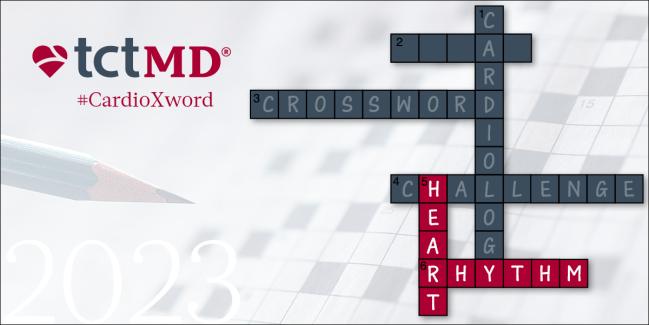Top Heart Rhythm News of 2023
The field saw big news come out around pacing, catheter ablation, and medical therapies for patients with AF.

Headlining news of catheter ablation for AF (AFABLATION; 6 Across*) were the CASTLE-HTx trial, which demonstrated a benefit of the procedure in patients with advanced heart failure who were being considered for heart transplantation or implantation of an LV assist device, and two trials of pulsed-field ablation (PFA)—PULSED AF and ADVENT (13 Down).
There is hope that PFA, which ablates using electroporation rather than thermal energy, will allow electrophysiologists to perform shorter, safer procedures. PULSED AF, a single-arm, pivotal trial presented at the American College of Cardiology/World Congress of Cardiology (ACC/WCC) 2023 meeting in March, showed the PulseSelect system (Medtronic) to be a safe and effective way to achieve freedom from arrhythmias in patients with either paroxysmal or persistent AF. The findings supported the US Food and Drug Administration’s approval of the PulseSelect system, the first PFA technology that will be available to US operators, in December.
ADVENT, presented at the European Society of Cardiology Congress 2023 in August, provided the first randomized, head-to-head trial comparing PFA with radiofrequency or cryoballoon ablation. The Farapulse system (Boston Scientific) proved noninferior to thermal ablation, with less pulmonary vein narrowing and shorter total procedure and ablation times.
In the realm of device therapies for patients with AF, left atrial appendage occlusion (LAAO; 20 Across) for stroke prevention continued to make its mark. The Society for Cardiovascular Angiography and Interventions and the Heart Rhythm Society released an expert consensus statement to provide evidence-based recommendations for best practices and to incorporate several years of advancements in techniques, devices, and imaging, as well as mounting evidence from trials and registries.
In addition, the WATCH-TAVR trial, presented at TCT 2023, showed that adding LAAO at the time of TAVI provided noninferior outcomes compared with TAVI alone among patients with severe aortic stenosis and AF.
Recommendations around both AF ablation and LAAO were strengthened in a full update to the US AF guidelines released in November.
Insights Into Medical Therapies for AF
In the past year, both positive and negative results have come out of trials investigating various drug therapies for either device-detected (subclinical) or clinical AF.
First, NOAH-AFNET 6, presented at the European Society of Cardiology Congress 2023, demonstrated that edoxaban (Savaysa; Daiichi Sankyo) didn’t improve clinical outcomes, and in fact increased the risk of all-cause death or major bleeding, among patients with atrial high-rate episodes detected by implanted cardiac devices. Then, at the American Heart Association (AHA) 2023 Scientific Sessions in November, attendees heard the results of ARTESiA (32 Down), which showed that apixaban (Eliquis; Bristol Myers Squibb) reduced stroke or systemic embolism at the cost of more major bleeding in patients with subclinical AF detected on implanted devices.
A subsequent meta-analysis of the two trials, published in Circulation, indicated that direct oral anticoagulants (DOACs) reduce ischemic stroke by a relative 32% while increasing major bleeds by a relative 62%.
If last year looked promising for a novel class of anticoagulants being developed to mitigate bleeding risk while maintaining clinical efficacy, 2023 has been decidedly mixed for the factor XI/XIa inhibitors. At the AHA meeting, investigators unveiled the phase II AZALEA-TIMI 71 trial, showing that subcutaneous, one-a-month abelacimab (Anthos Therapeutics) is far less likely to lead to major and nonmajor clinically relevant bleeding than rivaroxaban (Xarelto; Bayer/Janssen) in atrial fibrillation patients at moderate-to-high risk of stroke. The phase III OCEANIC-AF trial (OCEANICAF; 33 Across), however, was stopped early after the investigational factor XIa inhibitor asundexian (Bayer) didn’t measure up to apixaban in patients with AF at risk for stroke.
More-promising news came from the phase II ReVeRA-201 study, which evaluated the use of a novel nasal spray containing etripamil (Milestone Pharmaceuticals), an L-type calcium channel blocker (CCB; 50 Down), in patients with AF accompanied by a rapid ventricular rate. The treatment, which has previously demonstrated positive results in patients with paroxysmal supraventricular tachycardia, provided a rapid reduction in ventricular rate in this new setting.
An old anticoagulant also pulled off a surprising win: in FRAIL-AF (FRAIL; 46 Down), presented at ESC 2023, frail elderly patients who were switched off warfarin to a DOAC experienced significantly greater risks of major or clinically relevant bleeding than did those who remained on the vitamin K antagonist.
Pacing and ICDs
As in recent years, the past 12 months have continued to see mounting data in support of conduction system pacing, which includes both left bundle branch area pacing (LBB; 4 Down) and His-bundle pacing (HIS; 21 Down).
In a large observational study presented at the Heart Rhythm 2023 meeting in May, left bundle branch area pacing (LBBAP) provided better clinical outcomes compared with biventricular pacing in patients treated with CRT. And the HOT-CRT pilot study published in September showed that for patients with an indication for CRT, His-Purkinje conduction system pacing provided a bigger boost to LV function than biventricular pacing.
Conduction system pacing has been gaining traction around the globe and has been included in pacing guidelines from the US and Europe. The European Heart Rhythm Association (EHRA) released a consensus statement on conduction system pacing to standardize implantation technique and provide direction to physicians who want to perform the procedure in April.
Also in this area, the DANPACE II trial explored the optimal pacing rate in patients with sinus node dysfunction (NODE; 18 Down) and dual-chamber pacemakers, showing that reducing atrial pacing did not lower the risk of developing AF, but did increase the likelihood of developing presyncope or syncope.
Among other noteworthy news in heart rhythms, the US Food and Drug Administration approved the first extravascular implantable cardioverter-defibrillator (EVICD; 16 Across)—the Aurora EV-ICD along with its Epsila EV defibrillation lead (Medtronic)—in October. The device, designed to avoid potential problems associated with transvenous leads, is implanted under a patient’s armpit with the leads placed under the sternum.
A View From Europe
Speaking with TCTMD, EHRA President Jose Merino, MD, PhD (La Paz University Hospital and Universidad Autónoma de Madrid, Spain), reflected on the major developments in heart rhythm in 2023, identifying the ADVENT trial of PFA and the CASTLE-HTx trial of ablation in patients with advanced heart failure as high points.
He highlighted that ablation reduced all-cause mortality in the latter trial, saying, “this is important because this will make ablation a more-acceptable therapy in the future” and result in many more patients getting referred for the procedure.
Accumulating data on conduction system pacing also was front of mind for Merino. The concept is not new, he said, but it is growing in use because it is more physiological and is associated with better hemodynamics. “This is becoming more and more popular, and even the standard of the market.”
His-bundle pacing started the trend, but LBBAP has begun to take over since it is technically less challenging, the lead is more stable, and the pacing thresholds are lower, Merino said, adding that very few centers are still using pure His-bundle pacing.
Merino also highlighted the NOAH-AFNET 6 and ARTESiA trials evaluating DOAC therapy in patients with subclinical AF before noting that the factor XI/XIa inhibitors that are being developed might provide a better balance between the benefits and risks of anticoagulation. In that context, the stoppage of OCEANIC-AF for lack of efficacy was “not good news,” he said.
*All of our end of year stories for 2023 contain clues to our Cardiology Crossword Challenge.
Todd Neale is the Associate News Editor for TCTMD and a Senior Medical Journalist. He got his start in journalism at …
Read Full Bio




Comments